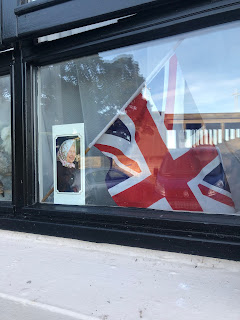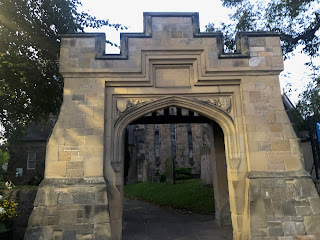Yesterday morning we awoke to a bright blue sky with just a slight nip in the air, so we seized the opportunity for an early morning outside adventure right in the backyard of our B&B. We are staying on the grounds of an older water mill, hidden from the world, with a small stream running along the back yard. Peace and tranquility at our fingertips.
I walked around the grounds, absorbing the beauty that surrounded me,
while Marty pretty much walked up and down the stream in search of the excitement of a catch. He tells me that he had a couple of bites, but wasn't quick enough to actually get a photo. (We've all heard that story before...right?)
We then headed inside for some breakfast before heading on the road north to Wallington, a large estate run by the National Trust. I know that I've mentioned previously that we are Royal Oak Members, which partner with the National Trust of England as well as Scotland. One pays a membership fee for the year and is issued a card that allows entry at no charge. I decided that after paying for a membership for several years gone untouched, we were going to see as many of these "free" establishments that I could muster. You better believe my goal is to get my money's worth out of the investment!
This estate is located among the rolling hills of the country, and the weather certainly made for a picture perfect day. Probably a bit too perfect as it seems as if I took a boat load of photos, but I'll try to curb my enthusiasm regarding posting.
After entering through the stables,
the house stands grandly in the distance.
We showed up just in time for the house opening, and we were permitted to walk along the bottom floor rooms at our leisure, but there were guides in house to answer any questions that we might have.
The house was built in 1688 by Sir William Blackett who used it as a hunting estate. It was passed down to his nephew, Walter, who transformed it into the building that it is today.
He not only added the clock tower through which we entered, but interior staircases with room improvements as well as gardens on the grounds for pleasure. Upon his death, the house passed to his sister’s son, John Trevelyan, which is the family line that held the house for centuries before being gifted to the National Trust.
I was enthralled with the beauty in the rooms. There were such fine detail, from the mirrors and embellishments on the walls to the plaster work on the ceiling.
There were information "plates" set up around the room, giving an insight to the every day life of the family living among these rooms. Isn't that clever?
I walked through to the parlor and was taken aback at the beauty of the color scheme.
and I had to chuckle when I saw that Marie Trevelyan not only stitched her name on this tapestry, but also included the years that it took to finish.
Twenty three, it appears, and I can't blame her for wanting people to know that!
The house contains items from George Macauley, who wrote the first edition of the History of England. This clock is among one of those items.
One of the rooms had an odd color difference on the wall paper. When I asked why there was a variation, I learned that there had been water damage at the top of some of the walls, and the paper had peeled. The National Trust wanted to be sure to keep the integrity of the original rooms, so the curator had planned on finding wallpaper that would match the original. The owner of the house at the time suggested that they look to see if there was any left over paper in the attic of the house, and sure enough, there it was. So the trust patched it to blend, but, obviously, the original paper on top, had somehow managed to maintain the original colors that had faded over time on the wall.
Now, does this imply that one should keep extra rolls of wallpaper in the attic, just in case? I'll leave that decision up to you. I certainly found it amusing that it was an advantage in the upkeep of this ancient home.
This woman, Julia, was instrumental in many of the upgrades in the house.
She commissioned a center atrium, with sun lights in an arched ceiling above, allowing light to brighten the room. Around the walls, she had paintings of historic events, beginning with one depicting the building of Hadrian's wall.
and including important events in history, like the story of the Darling family who aided the men who were victims of a ship's crash into the rocks along the shore of Northumberland.
There were also motifs of famous men featured on the walls as well.
Unfortunately, it appeared that several were famous for having been beheaded.
The Trevelyan family were no strangers to royalty, having been invited to no less than three coronations, including that of Queen Elizabeth in 1953.
One of the rooms held a collection of dollhouses that were on display, although they are not associated with the family who lived in the house.
The details were quite amusing, and extremely detailed. I could just see little girls having a grand time playing with these remarkable structures.
After spending quite a bit of time scouring the collections in the house, we decided to head to the gardens, and the first thing we passed was this tree with doors in the trunk. I have no idea who lives there.
We saw several giant redwood trees on the grounds
as well as some comfy benches for enjoying the views.
Although a lot of the blooms have faded this time of year, the gardens still had a wide array of beauty to enjoy.
We stopped for our daily cuppa and scone, which actually was a bit of a commotion when a dozen or more bees decided that my jam, placed upon my scone, would be a tasty treat. We did manage to escape any harm, but at last look, the little glass vial that held the jam was crammed with bees attempting to lick it clean. Whew!
From here we headed in search of Hadrian's wall. We were unsuccessful in reaching the wall when we attempted several years ago when Marty was working in Scotland, and I made it a goal to reach it on this trip. And, so we did!
It is run by English Heritage, in conjunction with the National Trust, so admission was free, of course.
It's a bit of a hike to the top to view the wall, and along the way, one passes through a long field filled with sheep grazing.
Once at the top, the views are amazing.
Where the gatehouse once stood, guarding the fort just below the wall, an ornate building has been built by the local townspeople.
I'll admit....I'm not a fan. I can appreciate the natural beauty of ruins without needing to embellish it for whatever reason. I will admit that the view from standing on one of the interior platforms, was pretty amazing, and gave one the idea of what it looked to the Roman Soldiers back in the first century.
We took the time to enjoy the views around us. It was nearly 5:00 pm at this time, when access would be closed.
We felt very lucky to have such beautiful weather to enjoy the experience.
Dinner was in Greece.
Well, Hexam's version of Greece.
And, it was delicious!
I'm behind getting this blog out, so it's time to get out and enjoy this new day!
























































































